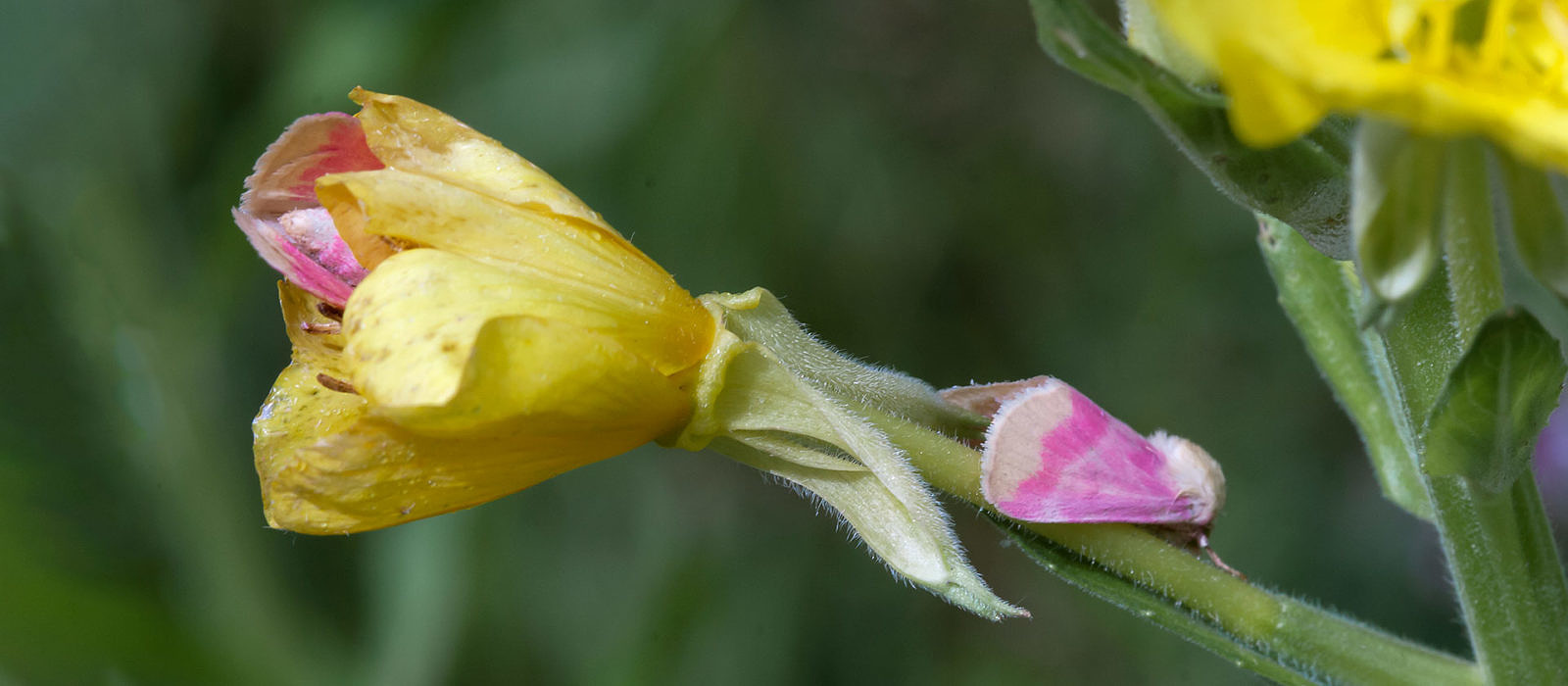
“Settled in Quivering Contentment”
The Elegant Adaptation of the Primrose Moth
Like most of you, I spend my summer leisure time contemplating the proboscis of the Primrose Moth, which is about half the length of its body.
That anatomy alone might be enough to kindle your interest in this insect. But now consider that the Primrose Moth is Pepto-Bismol pink with a lemony margin at the tips of its wings. In that pink presentation and probing proboscis, the Primrose Moth offers us a lesson in form, function and evolution by means of natural selection.
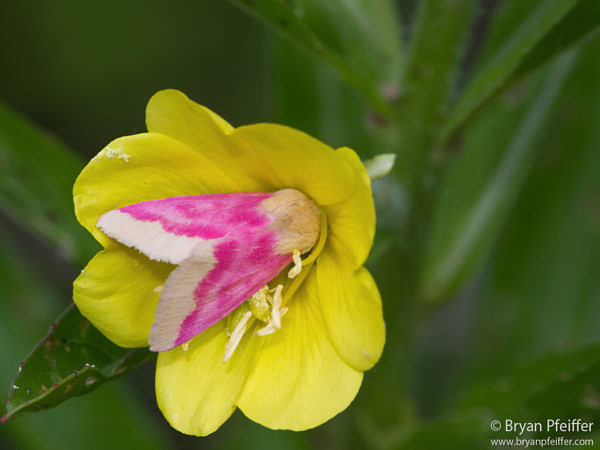 Primrose Moths (Schinia florida) fly around searching for the Evening Primrose (Oenothera biennis), a common garden and roadside plant with a dangling, elegant yellow flower. The primrose flower opens at night to the moth, and then usually closes by day. So a moth lingering in the flower until dawn gets an intimate embrace of petals.
Primrose Moths (Schinia florida) fly around searching for the Evening Primrose (Oenothera biennis), a common garden and roadside plant with a dangling, elegant yellow flower. The primrose flower opens at night to the moth, and then usually closes by day. So a moth lingering in the flower until dawn gets an intimate embrace of petals.
Besides the hug, the moth gets nectar. I’m not actually sure what the plant gets out this deal. The moth doesn’t appear to pollinate Evening Primrose, according to botanists and scientific literature published on this particular encounter of insect and plant. In fact, the moth seems to get the best of this relationship. The female lays her eggs on the Evening Primrose, and when the caterpillars emerge they start munching the plant where it hurts: the flower buds.
In any event, most of the action happens at night, when the primrose springs open its flower and the moth plunges head-long into the blossom. Even so, alert flower watchers among us can now witness, in broad daylight, this meeting of moth and bloom. Buried in a blossom after a night of binge-nectaring, the Primrose Moths are like a drunk passed out at the bar at dawn.
But this encounter also turns out to be an example of the struggle for existence and the shared evolution of insects and plants.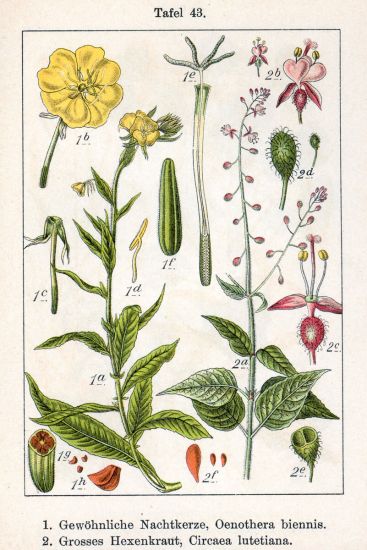 Those pink wings are often buried out of sight in yellow flowers (as in the banner image above). The portions still visible are the trailing edges, the yellow edges, which conveniently resemble the yellow edges of the primrose petals. The moth has evolved with camouflage so that it can sit and drink nectar, presumably unnoticed by predators.
Those pink wings are often buried out of sight in yellow flowers (as in the banner image above). The portions still visible are the trailing edges, the yellow edges, which conveniently resemble the yellow edges of the primrose petals. The moth has evolved with camouflage so that it can sit and drink nectar, presumably unnoticed by predators.
One of my favorite naturalists, William Hamilton Gibson, says we can hardly know the Evening Primrose until we know its nighttime visitor. Gibson was an exuberant 19th century writer and illustrator. In his 1892 book “Sharp Eyes,” a collection of essays and illustrations through the seasons (which you must own) Gibson revels in the moth and its blossom:
“Is this a mere withered, useless blossom that droops upon its stem? Is it not rather the prettiest luminous fairy tent that ever sheltered a day-dream? Last night, when its four green sepals burst from their cone, and sprang backward to release their bright, glossy petals, a small moth quickly caught the signal, and settled in quivering contentment, sipping at its throat. Its wings were of the purest rose-pink, bordered with yellow.”
Gibson continues:
“In the color of its marking, we find an outward expression of its beautiful sympathy, the yellow margins of the wings which protrude from the flower being quite primrose-like, and the pink being reflected in the rosy hue which the wilting primrose petals so often assume, especially at the throat.”
Did you catch that “beautiful sympathy?” First, the yellow match: wing tips and petal. But there’s another: a wilted primrose flower turns pinkish. So a primrose moth merely sitting on the stem of the plant may resemble an old flower and still find safety in the color pink. Evolution by means of natural selection (or so I assume).
What we cannot see in this little drama is the moth’s proboscis lapping nectar from the base of a primrose blossom. But we might deduce it. Take a close look at the flower at the upper left in the botanical illustration above. Below the base of the petals, the flower has a long, slender tube called the hypanthium, a long reach for a moth seeking nectar. No matter. In nature form follows function. The moth unfurls its built-in drinking straw for a sweet reward in that hypanthium.
So, this August, get your own sweet drink to go — and enjoy it in the good company of an Evening Primrose and its illustrious visitor. If you find one, and are so inclined, send me a photo. I’ve created a gallery of your images below.
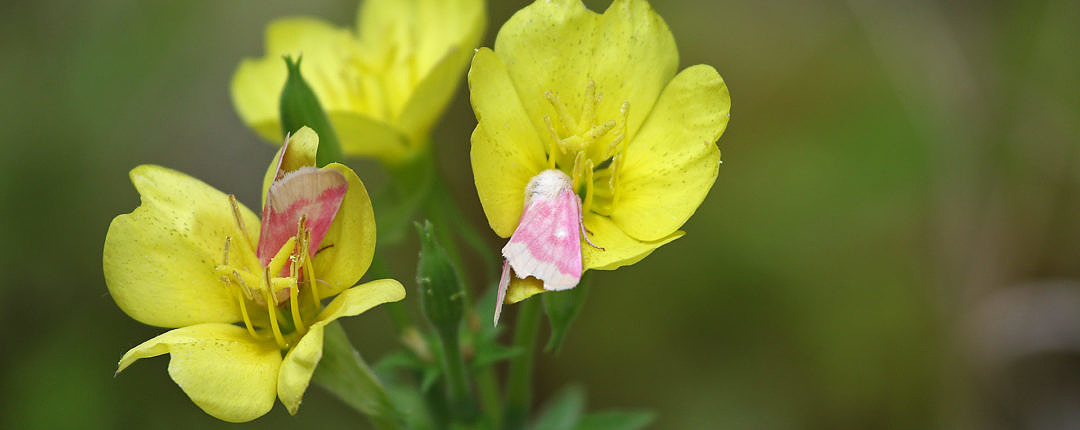
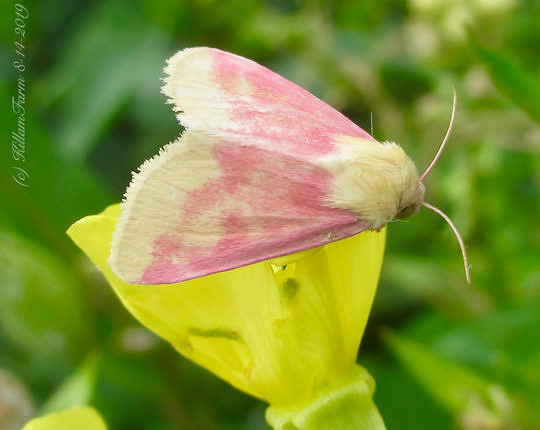
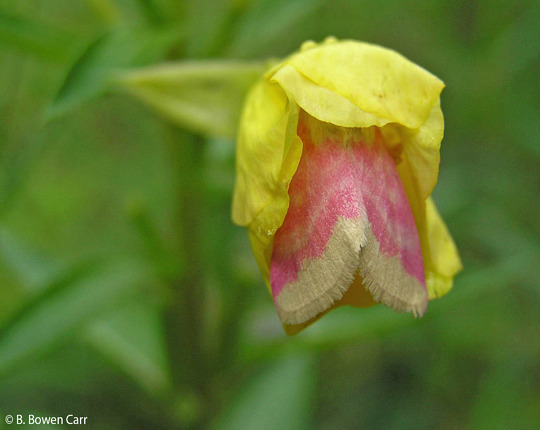
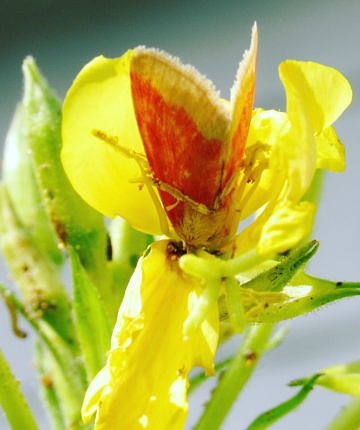
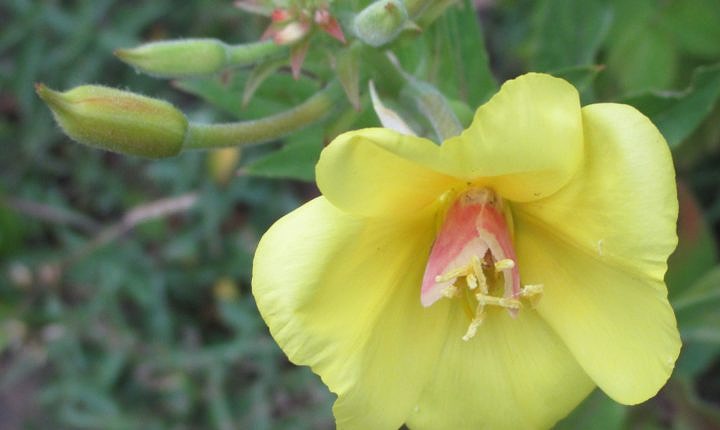
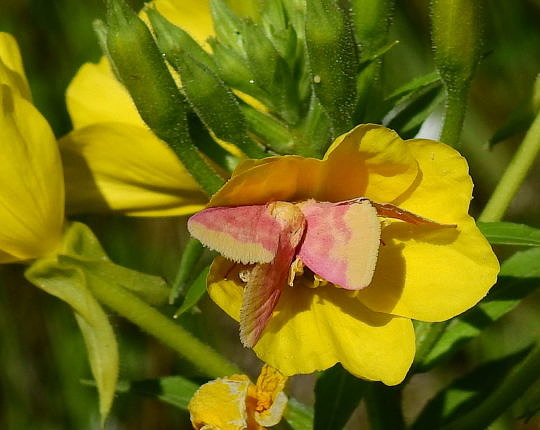
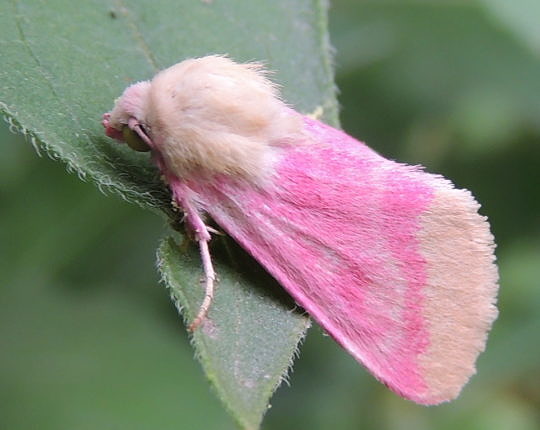

Or just save a few! The rewards may be shocking pink!
Uh, oh. We’ve been pulling this “weed” the last few years. Now we’ll – perhaps – lit it be and settle.
I do indeed remember that crab spider! 🙂 Been seeing lots of them this summer.
You’ll love Gibson, Kerstin. An FN if there ever was one!
Thanks, David. A very nice small gesture indeed. Remind me to chat about it with you next month! 🙂
Do you remember when I found that crab spider on Monhegan? That surprised me. I don’t think he flew in!
I love this! Thank you, Bryan, for this utterly fascinating, informative, and beautiful blog post. The association with the Gewöhnliche Nachtkerze seems like a very good deal for the moth indeed – a hug and nectar. I had’t heard of William Hamilton Gibson, but I already like him just for “settled in quivering contentment”!
Hi Bryan, Enjoyed your piece on the Primrose Moth. Over the past decades I have noticed the decline in insects of all kinds. I know this is well documented. A while back I began to think about the thousands upon thousands of insects of countless species that come to our garage lights every single night and I realized I am disrupting their breeding. I no longer turn on our outside lights at night. One more small contribution.
Thanks, Pete!
Thanks, Doc. Yeah, these Northeast meetings have been going well.
Thanks, Helen. Well, it can be easy when the subject matter is so compelling. 🙂
Thanks, David. Likewise, I enjoy your adventures afield!
Hi Jan,
“Wiggly finger” — love it! Nope, that’s not the wiggly finger protruding. Not sure what it is, actually. But the proboscis is really skinny.
Yes, it’s possible on Monhegan. (Anything’s possible on Monhegan :-)) There is a record of Primrose Moth from Vinalhaven. Monhegan, of course, if farther out to sea — but we won’t know unless we look!
Do you think I might see these on Monhegan? We do have evening primrose out on the island.
Hey Bryan.
One of our grandsons lasting take a ways from a True Insect 4 Winds lesson, was the word ” proboscis”, and the wiggly finger off the nose.
My question is, is that the proboscis protruding out the front of the flower? Life long learner.
Thank you for your blog!
Jan
Beautiful. I was just admiring primrose and now get to enjoy your writing.
Your photos are unbelievable!!!
Great post Bryan. I enjoyed it. Good to see you in Vermont. It was a good survey for me.
Doc
Thanks, Pete! And great shots B! I thoroughly enjoyed them. Sorry to hear that the highway department has been too busy cutting.
-Bryan
Excellent post. Thanks, Bryan for some wonderful info !
Thanks so much for this wonderful article & for the information on William Hamilton Gibson’s book. The Primrose Moth has been one of my favorites, ever since I discovered it, at the end of my driveway in Columbia County, New York, in July of 2008. Now, I look for them, each year. Sadly, the highway department, in my area, has seen fit to trim the edges of the roadways & we’ve lost most of the wildflower habitat. Here is a link to my set of Primrose Moth photos:
http://www.flickr.com/photos/mudder_bbc/sets/72157627214934575/
Thanks, Anne. Here’s another one to watch for, the similar Rosy Maple Moth, which also shows up around the house (often early in the season) here in Vermont: http://www.butterfliesandmoths.org/species/Dryocampa-rubicunda
Thanks, Emily. I look at A LOT of Evening Primroses! Let me know if you find one of the Pepto-Bismol delights!
Often find these moths, among many others, on my door in the morning. I love this particular species and never knew the connection to their head first foray into the evening primrose! Love it!
Fantastic, thanks for this (new to me) information. I’ll be spending time in the evenings and at dawn staring at my neighbors’ evening primrose until I catch a glimpse of this beauty.
Thanks, Kim. I love it when people report that they find this kind of stuff. Makes my day!
Hi Bryan,
I saw my first one last summer and wondered what it was – hard to believe I had never seen one until then! I was quite smitten by it’s color and thought to ask you what it would be – now one year later I know! Thanks!
Hi Dick,
Canon 20 with the 100mm macro shooting at 1/320th and f13 and some light from the flash (Canon SpeedLite 580).
Thanks, Carol. Let me know when you find one!
Excellent note and picture Bryan.
What camera, lens, F/?, Speed????
Such a fine description. I’ve never seen one…but now I’ll be looking.